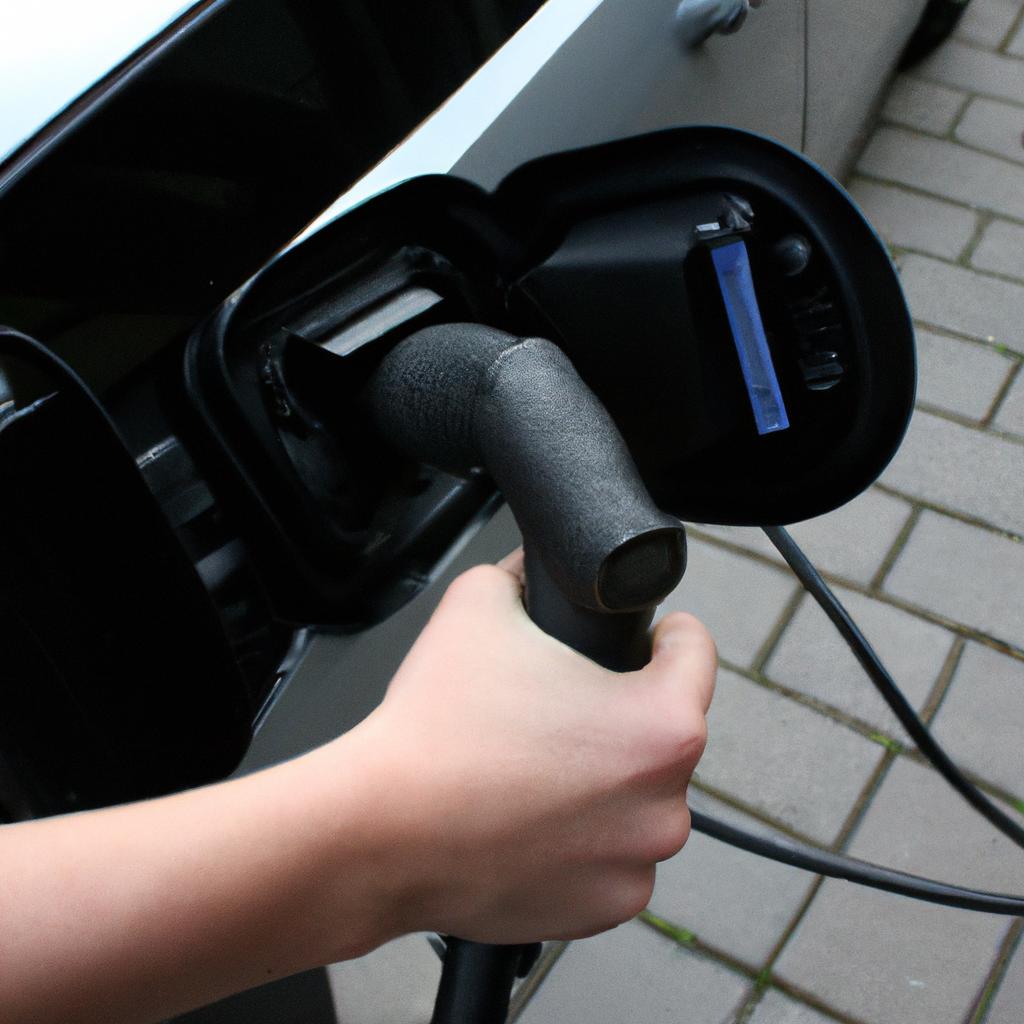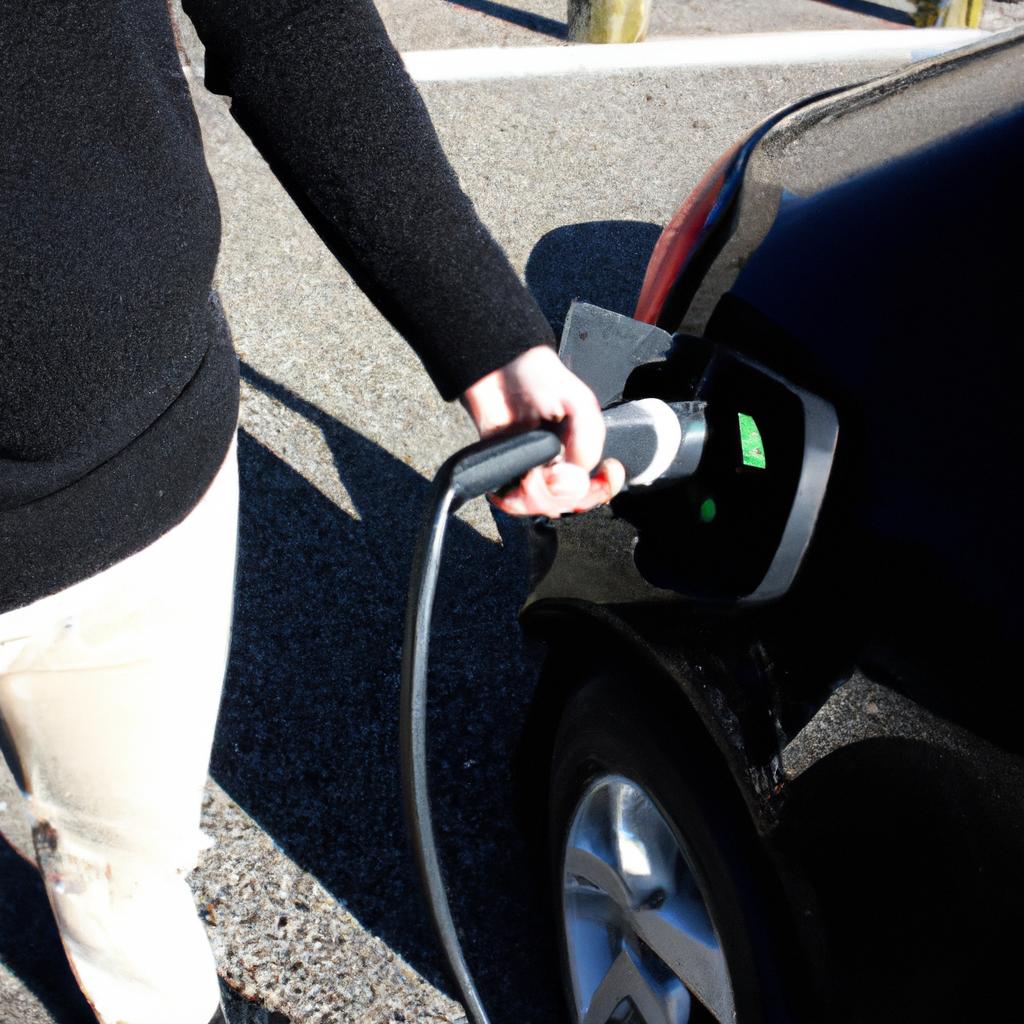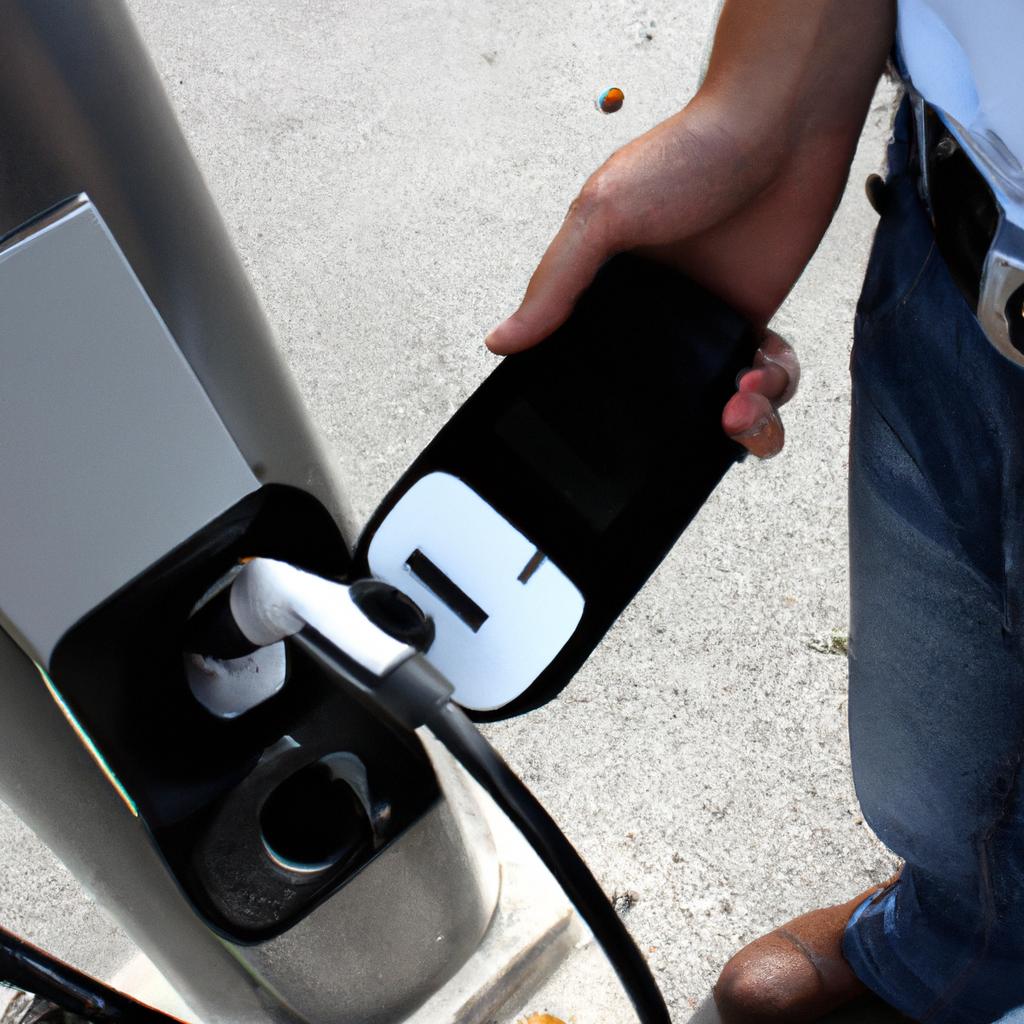The rise in popularity of electric vehicles (EVs) has brought about the need for an efficient and convenient charging infrastructure. As more individuals choose to transition from traditional gasoline-powered cars to EVs, the demand for reliable payment methods for accessing charging stations becomes paramount. This article explores various payment options available for EV charging infrastructure, focusing on their efficiency and convenience.
Imagine a scenario where John, an EV owner, travels to a nearby city and finds himself running low on battery power. He locates a public charging station but is perplexed by the multiple payment options available: credit card swipe, mobile app, RFID card, or direct billing. The choices can be overwhelming, especially when time is of the essence. In such instances, it becomes imperative to have streamlined payment methods that are both efficient in terms of transaction speed and convenient for users’ needs.
This article aims to examine different approaches adopted globally concerning payment methods for EV charging infrastructure. By analyzing real-world case studies as well as hypothetical scenarios, we will evaluate the advantages and disadvantages associated with each option. Additionally, we will explore potential future developments in this field that could bring further improvements to the overall user experience while also considering factors such as security concerns and interoperability between different networks. Ultimately, understanding these Ultimately, understanding these payment options will help EV owners make informed decisions when it comes to choosing the most efficient and convenient method for accessing charging stations. It will also provide insights for industry stakeholders, such as charging station operators and policymakers, to create a robust and user-friendly infrastructure that encourages widespread adoption of electric vehicles.
Direct debit
Direct debit is a popular and convenient payment method for electric vehicle (EV) charging infrastructure. For instance, consider the case of a hypothetical EV owner named Sarah who frequently uses public charging stations. By setting up a direct debit with her chosen charging network provider, Sarah can have her monthly charging expenses automatically deducted from her bank account without the need to manually make payments each time she charges her vehicle.
One advantage of using direct debit as a payment method is its efficiency. With this system in place, EV owners like Sarah do not have to worry about carrying cash or credit cards specifically for charging purposes. Instead, they can simply connect their bank accounts to their preferred charging network provider and enjoy seamless transactions whenever they charge their vehicles.
Moreover, direct debit offers convenience by eliminating the need for manual intervention during the payment process. Once the initial setup is complete, EV owners can focus solely on plugging in their vehicles at charging stations without having to handle any monetary transactions themselves. This streamlines the overall user experience and encourages more individuals to embrace electric mobility.
To further illustrate the benefits of direct debit, here are some key points:
- Convenience: Direct debit simplifies the payment process by automating billing and reducing administrative tasks.
- Cost control: Users can easily track their charging expenses through regular statements provided by their bank or charging network provider.
- Security: Since no physical exchange of money takes place during each transaction, there is reduced risk associated with theft or loss.
- Flexibility: The ability to link multiple vehicles to a single direct debit account allows households with multiple EVs to manage all their charging costs efficiently.
Considering these advantages, it becomes evident that direct debit provides an efficient and hassle-free way for EV owners to pay for their usage of electric vehicle charging infrastructure. In our subsequent section on “Credit or debit card,” we will explore another commonly used payment method in this context.
Credit or debit card
Efficient and Convenient Options: Credit or Debit Card
Transitioning from the previous section on direct debit, another widely used method for payment in electric vehicle (EV) charging infrastructure is through credit or debit cards. This method offers a convenient and efficient way for EV owners to make payments at charging stations across various locations.
To illustrate the advantages of using credit or debit cards, let us consider the case study of John, an EV owner who frequently travels long distances. During his recent road trip, he needed to charge his vehicle multiple times along the way. At each charging station, John simply inserted his credit card into the payment terminal provided by the station operator. Within seconds, the transaction was processed securely, allowing him to continue his journey without any delays.
There are several key benefits associated with this payment option:
- Convenience: Using credit or debit cards eliminates the need for carrying physical cash or searching for specific denominations while paying at charging stations.
- Wide Acceptance: Most charging stations accept major credit and debit cards as a standard form of payment, ensuring compatibility across different networks and locations.
- Transaction Speed: The seamless integration between card readers and charging infrastructure allows for quick processing times, minimizing waiting periods for EV owners.
- Security: Transactions made with credit or debit cards employ encryption technology that safeguards sensitive customer information against potential breaches.
To further highlight these advantages in a concise manner, we present a table summarizing them below:
| Advantages |
|---|
| Convenience |
| Wide acceptance |
| Transaction speed |
| Security |
In conclusion
Transitioning smoothly into our next topic regarding mobile payment apps, it is worth noting that credit or debit card options provide a robust foundation for electronic transactions in EV charging infrastructure. By offering ease-of-use and secure transactions, they have become an indispensable choice among both operators and consumers alike.
Next section: Mobile Payment Apps
Mobile payment apps
- Mobile Payment Apps
With the increasing popularity of smartphones, mobile payment apps have emerged as a convenient and efficient option for electric vehicle charging infrastructure payments. These apps allow users to link their bank accounts or credit cards to make seamless transactions at charging stations. For instance, a case study conducted by GreenCharge, an electric vehicle charging solutions provider, demonstrated how their mobile app streamlined the payment process for EV owners in a large metropolitan area.
To understand the benefits of using mobile payment apps for electric vehicle charging infrastructure, consider the following advantages:
- Convenience: Mobile payment apps enable users to pay for charging services directly from their smartphones, eliminating the need to carry physical credit or debit cards.
- Efficiency: These apps often provide real-time data on available charging stations and their occupancy status, allowing users to plan their trips more efficiently.
- Security: Advanced security measures such as encryption and two-factor authentication are typically implemented in these apps, ensuring secure transactions.
- Rewards and incentives: Some mobile payment apps offer loyalty programs that reward users with discounts or points for frequent usage or referrals.
| Benefit | Description |
|---|---|
| Convenience | Paying for charging services directly through smartphone applications |
| Efficiency | Real-time data on available charging stations and occupancy status |
| Security | Implementation of advanced security measures like encryption and two-factor authentication |
| Rewards and Incentives | Loyalty programs offering discounts or points based on frequency of usage or referrals |
Incorporating mobile payment apps into electric vehicle charging infrastructure offers numerous benefits to both EV owners and operators. By simplifying transactions and providing additional features like real-time information on station availability, these apps contribute towards enhancing user experience while promoting widespread adoption of electric vehicles.
Moving forward, we will explore another alternative method – prepaid cards – which can be used effectively within the context of electric vehicle charging infrastructure without relying solely on traditional means of payment.
Prepaid cards
Transitioning from mobile payment apps, another popular option for paying for electric vehicle (EV) charging is through prepaid cards. These cards offer users a convenient and flexible way to manage their charging expenses. To illustrate the benefits of this method, let’s consider a hypothetical case study involving Sarah, an EV owner who frequently uses public charging stations.
Sarah decides to purchase a prepaid card specifically designed for EV charging. She finds that one major advantage of using such cards is the ability to budget her charging costs effectively. By loading a certain amount onto the card in advance, she can monitor her usage and ensure that she stays within her desired spending limit. This feature allows Sarah to have better control over her overall expenses related to EV charging.
In addition to financial control, prepaid cards also provide convenience and accessibility. Many service providers offer these cards with various denominations and top-up options available at multiple retail locations or online platforms. This widespread availability makes it easy for EV owners like Sarah to find and purchase these cards whenever needed. Furthermore, most prepaid cards are compatible with different charging networks, allowing users access to a wide network of chargers without any additional hassle.
When considering the benefits of prepaid cards as a payment method for EV charging infrastructure, several key advantages stand out:
- Budget management: Prepaid cards enable users to set limits on their charging expenses upfront.
- Convenience: The availability of prepaid cards at multiple locations simplifies the process of obtaining them when required.
- Compatibility: Most prepaid cards work across various charging networks, enhancing accessibility for users.
- Easy tracking: Users can easily track their remaining balance and recharge their card as needed.
To further highlight the distinct features of different payment methods in an engaging format, we present below a comparison table showcasing some key characteristics:
| Payment Method | Advantages | Disadvantages |
|---|---|---|
| Mobile Apps | Convenient, real-time access | Limited compatibility |
| Prepaid Cards | Budget management, accessibility | Manual recharge |
| Pay-as-you-go options | Flexibility, no upfront commitment | Potentially higher costs |
Moving forward, the next section will discuss pay-as-you-go options for EV charging. This method offers an alternative approach to payment that may appeal to those seeking flexibility without any long-term commitments or prepayments.
Pay-as-you-go options
Section H3: Mobile Applications for Electric Vehicle Charging
Mobile applications have become an increasingly popular and convenient way to facilitate payments for electric vehicle charging. For instance, let’s consider the case of a tech-savvy EV owner named Emma who frequently uses her smartphone to manage various aspects of her daily life. Emma downloads a mobile application specifically designed for electric vehicle charging, allowing her to easily locate nearby charging stations, check their availability in real-time, and initiate charging sessions with just a few taps on her phone.
To further explore the benefits and features offered by these mobile applications, let us delve into some key advantages they provide:
- Convenience: With mobile apps, users like Emma can effortlessly find available charging stations near their current location or any specified destination. This eliminates the need to search manually or rely on outdated information from other sources.
- Real-time Updates: These applications often provide up-to-date information regarding the status of charging stations. Users can view if a station is occupied or available, ensuring efficient planning and minimal waiting times.
- Payment Integration: Many mobile apps offer seamless integration with payment methods such as credit cards or digital wallets. Upon completing a charging session, users can conveniently pay through the app without having to handle physical cash or prepaid cards.
- Rewards and Incentives: To encourage user engagement and loyalty, several apps incorporate reward programs that allow EV owners to earn points or discounts based on their usage frequency. Such incentives promote sustainable practices while adding an element of excitement for the users.
Below is an illustrative table showcasing four popular mobile applications used for electric vehicle charging:
| Application | Features | Compatibility |
|---|---|---|
| ChargePoint | Real-time station updates | iOS/Android |
| PlugShare | User reviews & ratings | iOS/Android |
| Electrify America | Charging session history | iOS/Android |
| Greenlots | Reservation of charging spots | iOS/Android |
In conclusion, mobile applications have revolutionized the way electric vehicle owners interact with and pay for charging services. By providing convenience, real-time updates, integrated payment options, and additional rewards, these apps enhance the overall EV charging experience.
Subscription-based plans
Section H2: Subscription-based plans
Subscription-based plans offer an alternative approach to paying for electric vehicle charging services. Instead of the pay-as-you-go model, where users are charged per session or kilowatt-hour consumed, subscription plans provide a fixed monthly fee in exchange for unlimited access to specified charging stations. This section examines the advantages and considerations associated with subscription-based plans.
To illustrate the benefits of subscription-based plans, consider the case study of GreenCharge Inc., a leading provider of electric vehicle charging infrastructure solutions. GreenCharge offers a subscription plan that allows customers to access their extensive network of charging stations across major cities. With a monthly fee of $50, subscribers enjoy unlimited charging sessions at any participating station within the network. This model provides convenience and peace of mind for EV owners who no longer need to worry about individual transaction costs or topping up their accounts before every charge.
When evaluating whether a subscription-based plan is suitable for one’s needs, several factors should be considered:
- Network coverage: It is crucial to assess the geographic availability and density of charging stations within the subscription plan’s network. A wider coverage ensures greater accessibility and reduces range anxiety among EV owners.
- Charging speed: Different subscription plans may have varying levels of charging speeds available at their stations. Understanding the offered charging rates can help users determine if they align with their requirements for efficient recharging.
- Additional perks: Some subscription plans come bundled with additional benefits such as priority access to popular stations during peak hours or exclusive discounts on other related services like parking fees or maintenance expenses.
- Flexibility and contract terms: Before committing to a subscription plan, it is important to review the contract terms regarding cancellation policies, upgrade options, and potential penalties for exceeding usage limits.
The table below summarizes key features and considerations when opting for a subscription-based plan:
| Feature | Description |
|---|---|
| Monthly Fee | Fixed amount paid monthly for unlimited access to charging stations within the network. |
| Network Coverage | Extent and density of charging stations available in different geographical areas. |
| Charging Speed | Varying levels of charging rates provided at the subscription plan’s stations. |
| Additional Perks | Extra benefits included with the subscription, such as priority access or discounts on services. |
In conclusion, subscription-based plans offer EV owners a convenient and hassle-free method of accessing electric vehicle charging infrastructure. The case study of GreenCharge Inc. highlights how this model can provide peace of mind while ensuring easy access to a broad network of charging stations. By considering factors like network coverage, charging speed, additional perks, and contract terms, users can make informed decisions when selecting a suitable subscription plan that meets their specific needs.
 Sfeva
Sfeva



